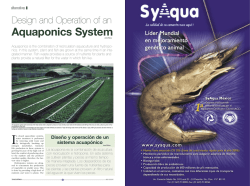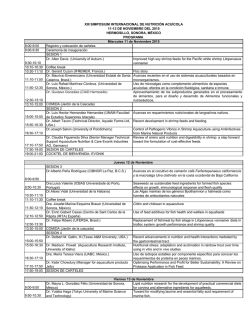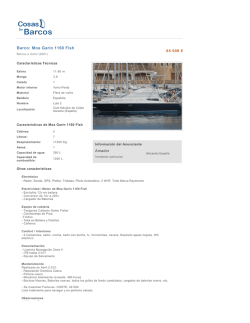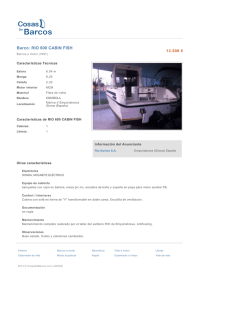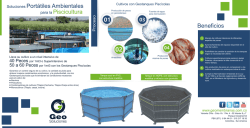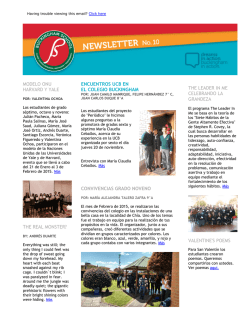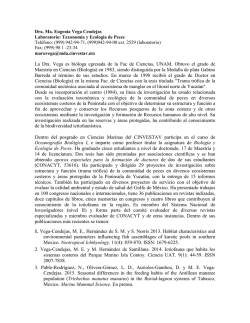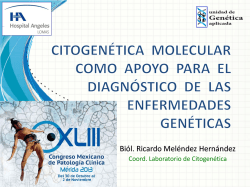
Descargar el archivo PDF - Revista Mexicana de Ciencias Agrícolas
Revista Mexicana de Ciencias Agrícolas Vol.7 Núm.5 30 de junio - 13 de agosto, 2016 p. 983-992 Determinación de la relación pez planta en la producción de tomate (Licopersicum sculentum L.) en sistema de acuaponia* Determination of relative fish plant in tomato (Licopersicum sculentum L.) production in aquaponic system Salvador Villalobos-Reyes1 y Enrique González-Pérez1§ Campo Experimenta Bajío. Instituto Nacional de Investigaciones Forestales, Agrícolas y Pecuarias. Carretera Celaya-San Miguel de Allende km 6.5, Colonia Roque, Celaya, Guanajuato, México. C. P. 38110. §Autor para correspondencia: [email protected]. 1 Resumen Abstract En la última década, la acuaponia en México ha tomado importancia económica, pero la información sobre este sistema de producción es limitada. Nuestro sistema de acuaponia fue diseñado para determinar la relación pezplanta adecuada para la producción de tomate. En tanques con 450 L de agua se sembraron alevines de tilapia con peso individual inicial de 0.45 g en tres densidades 120, 80 y 40 peces m-3. Los peces fueron alimentados diariamente a una tasa calculada sobre 7% del peso corporal por pez. Alimento comercial de 46% de proteína se usó durante un mes y de 28% de proteína para los 2 meses restantes. Un total de 48 plántulas de tomate fueron trasplantadas en tres camas de crecimiento (16 plantas por cama) 10 días después de la siembra de peces. La sobrevivencia de peces fue de 100%, el factor de conversión alimenticia fue de 1.18 y el peso final por pez fue de 62 g. Con la relación 20:1 se obtuvo plantas con longitud promedio de tallo de 160.6 cm, mayor número de frutos (9) y rendimiento promedio de 2.5 kg pta-1. La concentración de nutrimentos en el agua estuvo por debajo de los límites permitidos, sin embargo, la baja concentración de K y la ausencia de Fe y B afectaron el desarrollo de la planta después de 90 días. In the last decade, Mexico has taken aquaponics economic importance, but information on this production system is limited. Our aquaponics system was designed to determine the relationship fish-plant suitable for the production of tomato. In tanks with 450 L of water fingerlings they were seeded with initial individual weight of 0.45 g in three densities 120, 80 and 40 fish m-3. The fish were fed daily at a rate calculated on 7% of body weight per fish. The commercial feed 46% protein was used for a month and 28% protein for two months remaining. A total of 48 tomato seedlings were transplanted into three beds growth (16 plants per bed) 10 days after the stocking. Fish survival was 100%, feed conversion factor was 1.18 and the final weight per fish was 62 g. With the 20:1 ratio was obtained plants with average stem length of 160.6 cm, greater number of fruits (9) and average yield of 2.5 kg pta-1. The nutrient concentration in water was below the permitted limits, however, the low concentration of K and the absence of Fe and B affected the development of the plant after 90 days. Palabras clave: calidad de agua, crecimiento vegetal, nutrimento, proteína. Keywords: plant growth, protein, nutrient, water quality. * Recibido: febrero de 2016 Aceptado: mayo de 2016 984 Rev. Mex. Cienc. Agríc. Vol.7 Núm. 5 30 de junio - 13 de agosto, 2016 Salvador Villalobos-Reyes y Enrique González-Pérez Introducción Introduction Los sistemas acuícolas continuamente generan grandes cantidades de desechos, por lo que a partir del aprovechamiento de estos desechos se puede obtener otro producto que genere a su vez una ganancia económica adicional.Al integrar el sistema acuícola con la hidroponía se crea un modelo de producción denominado acuaponia, que se define como el cultivo de peces y plantas en un sistema de recirculación (Nelson, 2008), que podría servir para una producción sostenible de alimentos en policultivo lo que incrementa la diversidad y producción final, y la posibilidad de obtener productos con calidad fitosanitaria y con importantes impactos socio económicos al obtener beneficio económico (Diver, 2006). The aquaculture systems continually generate large amounts of waste, so from the use of these wastes can be obtained another product that generates in turn an additional financial gain. By integrating the aquaculture system with hydroponics a production model called aquaponics, defined as the cultivation of fish and plants in a recirculation system (Nelson, 2008), which could serve for sustainable food production in polyculture creates what increasing diversity and final production, and the possibility of obtaining phytosanitary quality products and with significant socioeconomic impacts to obtain economic benefit (Diver, 2006). La acuaponia tiene ventajas sobre otros sistemas de producción, como el sistema de recirculación de acuacultura y el sistema hidropónico que usan nutrientes inorgánicos. En acuaponia el componente hidropónico sirve como bio filtro, por lo que no es necesario utilizar otro filtro como en los sistemas de recirculación. Los cultivos en acuaponia controlan la acumulación de nutrientes residuales procedentes de la acuicultura, lo que reduce el consumo de fertilizantes y agua, sin demeritar la calidad y productividad de los cultivos (Roosta y Mohsentan, 2012). La alimentación de los peces proporciona la mayor parte de los nutrientes requeridos para el crecimiento de la planta. La mayoría de las especies de peces utilizan el 20-30% de nitrógeno (N) suministrado por la dieta (Piedrahita, 2003; Schneider et al., 2005), esto significa que aproximadamente el 70-80% de la N suministrado por la alimentación se libera en forma de residuos en el agua (Krom et al., 1995), siendo el amonio el producto final de la descomposición de las proteínas que los peces digieren de su alimentación y son disueltas en el agua por medio de sus heces fecales. La eficiencia de la nitrificación (un proceso crucial en la acuacultura, que reduce el nivel de amonio, que es una causa importante de la toxicidad para el cultivo de peces) es mayor en solución alcalina, pH 7.5-8, que es la razón del pH relativamente alto en la mayoría de las instalaciones de acuicultura (Savidov, 2004). Sin embargo, el crecimiento de la planta puede ser afectado por el pH alto (superior a 7), mientras que a pH de 5.8 se considera que hay mejor disponibilidad de nutrimentos en el cultivo hidropónico, pero se afecta el desarrollo y crecimiento de los peces (Boyd, 1992). En estudios previos se reporta que en el sistema de acuaponia los residuos de los Aquaponics has advantages over other production systems such as aquaculture recirculation system and hydroponic system using inorganic nutrients. In aquaponics hydroponics component serves as a bio filter, so it is not necessary to use other filters and recirculation systems. Aquaponic crops control the accumulation of residual nutrients from aquaculture, reducing the consumption of fertilizer and water, without detracting from the quality and productivity of crops (Roosta and Mohsentan, 2012). The fish feed provides most of the nutrients required for plant growth. Most fish species used 20-30% of nitrogen (N) supplied by the diet (Piedrahita, 2003; Schneider et al., 2005), this means that approximately 70-80% of the N supplied by the power is released as waste into water (Krom et al., 1995), the ammonium the end product of protein breakdown that fish digest their food and are dissolved in water through their feces. The efficiency of nitrification (a crucial process in aquaculture, that reduces the level of ammonia, which is a major cause of toxicity for fish farming) is higher in alkaline solution, pH 7.5-8, which is the reason relatively high pH in most aquaculture facilities (Savidov, 2004). However, the plant growth can be affected by the high pH (above 7), while at pH 5.8 it is considered that no better availability of nutrients in hydroponics, but the development and growth of fish affected (Boyd, 1992). In previous studies it is reported that in the aquaponic system waste fish provide nutrients to plants in low phosphorus (P), potassium (K), sulfur (S), iron (Fe) and manganese (Mn) (Seawright et al., 1998; Graber and Junge, 2009). Of the various systems aquaponic recirculation (Diver, 2006; Rakocy et al., 2006), for growing species such as tomato use bed system recommended by the management that requires the Determinación de la relación pez planta en la producción de tomate (Licopersicum sculentum L.) en sistema de acuaponia peces suministran nutrimentos a las plantas en bajos niveles de fósforo (P), potasio (K), azufre (S), hierro (Fe) y manganeso (Mn) (Seawright et al., 1998; Graber y Junge, 2009). De los diversos sistemas de recirculación acuapónicos (Diver, 2006; Rakocy et al., 2006), para el cultivo de especies como el tomate se recomienda el uso del sistema de camas por el manejo que requiere el cultivo, ya que el tomate en acuaponia es más difícil de producir en comparación con cultivos foliáceos, debido a la mayor demanda de nutrimentos en sus diferentes etapas de crecimiento (Sikawa y Yakupitiyage, 2010). Desde la germinación hasta el desarrollo de las primeras flores (6 semanas), las necesidades nutrimentales de la planta son constantes y cuando las plantas comienzan a producir frutos requieren más Ca, Mg, y K (Nelson, 2008). Existe limitada información sobre la producción y demanda de nutrimentos de tomate en sistema de acuaponia, estudios previos realizados por diversos autores se enfocan en el comportamiento del nitrógeno en el sistema, pero en ninguno se establece cuantos peces se necesitan para generar la cantidad de nutrimentos que demanda una planta. Con base en lo anterior, el objetivo de esta investigación fue determinar la relación pez-planta y su influencia en el crecimiento, desarrollo y rendimiento de plantas de tomate producidas en sistema de acuaponia. Materiales y métodos Sitio experimental La investigación se realizó en un invernadero tipo túnel de tecnología intermedia dentro de las instalaciones del Programa de Horticultura del Campo Experimental Bajío, INIFAP, ubicado en Celaya, Guanajuato a 20° 30´ latitud norte y 100° 49´ longitud oeste a 1 750 msnm. Sistema de acuaponia El sistema estuvo compuesto por tres unidades acuaponicas idénticas (Figura 1). Cada unidad consistió de un estanque de crecimiento de peces, una bomba de agua, dos filtros y una cama de crecimiento de plantas, con un volumen total de agua de 300 L. La unidad de crecimiento de peces fue un tanque de polietileno de 450 L, con aireación distribuida mediante una bomba de aire de 3 W conectada a dos difusores de aire (2 L min-1), ubicados en el centro del tanque. Los dos filtros (bote de plástico 20 L) contenían tezontle cribado con malla de 12 mm a un espesor de 30 cm colocado dentro de malla de polietileno 985 cultivation, as the tomato in aquaponics it is more difficult to produce compared to deciduous crops, due to increased demand for nutrients at different stages of growth (Sikawa and Yakupitiyage, 2010). From germination to the development of the first flowers (6 weeks), the nutritional needs of the plant are constant and when the plants begin to produce fruits require more Ca, Mg, and K (Nelson, 2008). There is limited information on production and nutrient demand tomato aquaponics system, previous studies by various authors focus on the behavior of nitrogen in the system, but none is set few fish are needed to generate the amount of nutrients that demand a plant. Based on the above, the objective of this research was to determine the relationship fish-plant and its influence on the growth, development and yield of tomato plants produced in aquaponics system. Materials and methods Experimental site The research was conducted in a greenhouse tunnel intermediate technology within the premises Horticulture Program Experimental Bajio, INIFAP, located in Celaya, Guanajuato at 20° 30´ north latitude and 100° 49´ west longitude to 1 750 msnm. Aquaponic system The system was composed of three identical aquaponic units (Figure 1). Each unit consisted of a pond fish growth, a water pump, two filters and a bed of growing plants, with a total water volume of 300 L. The fish growth unit was a polyethylene tank 450 L with aeration distributed by an air pump 3 W connected to two air vents (2 L min-1), located in the center of the tank. The two filters (plastic boat 20 L) containing tezontle screening mesh of 12 mm to a thickness of 30 cm placed within polyethylene mesh 30 months h white 50 cm2, which were drawn every two months. In the fish tank was installed submersible pump vane 40 W continuously propelled by the solution recirculating system through polyethylene tubing connections 16 mm. The recirculation cycle began with the water supply to the first filter which waste particles are retained, after passing through the filter water is distributed into the bed of growing 986 Rev. Mex. Cienc. Agríc. Vol.7 Núm. 5 30 de junio - 13 de agosto, 2016 de 30 mes h de color blanco de 50 cm2, los cuales fueron drenados cada dos meses. En el tanque de peces se instaló una bomba de paleta sumergible de 40 W, que impulsaba continuamente la solución por el sistema de recirculación mediante tubería de polietileno con conexiones de 16 mm. El ciclo de recirculación iniciaba con el suministro de agua al primer filtro donde se retenían partículas de residuos, después de atravesar el filtro el agua se distribuía en la cama de crecimiento de plantas mediante micro-tubin de polietileno flexible de 4 mm conectado a la tubería de polietileno y colocado a 5 ± 1 cm de distancia de las plantas, después de atravesar la cama de crecimiento, el agua era captada y dirigida al segundo filtro, para posteriormente regresar al tanque de peces ubicado en el punto más bajo del sistema. El flujo constante del micro-tubin fue de 8 L h-1. La unidad de crecimiento de plantas fue una charola metálica donde se utilizaron como macetas bolsas de polietileno de 32 L conteniendo tezontle previamente desinfectado con cuaternario de amonio (800 ppm). El volumen de agua en el sistema se mantuvo constante con reposiciones cada que se perdía más de 10% del volumen total. Caracterización fisicoquímica del agua Para monitorear la concentración de nutrimentos en el agua del sistema, se realizaron muestreos cada 15 días. Se tomaron tres muestras con 3 repeticiones en dos puntos del sistema: a) estanque y b) sitio de descarga y se determinó pH, conductividad eléctrica, amonio, nitratos, fósforo, potasio, calcio y magnesio. Para amoniaco y nitratos se utilizó un espectrofotómetro portátil modelo DR/2400 Hach ®, el fósforo (P) se determinó con el procedimiento de Bray y Kurts (1945), potasio (K) por el método de saturación (Hesse, 1971), y los contenidos de bases de calcio y magnesio por absorción atómica (Thomas, 1986). Cultivo de peces Para el experimento se emplearon 240 peces de tilapia (Oreochromis niloticus x O. aureus) con un peso individual inicial de 0.45 g, revertidos sexualmente con fluoximesterona (7.5 mg kg-1 de pez) por 25 días. Para determinar la relación pez-planta se cultivaron tres densidades de peces 120, 80 y 40 peces m-3 en cada unidad de acuaponia, con una biomasa total inicial de 56.4, 37.6 y 18.8 g pez m-3, respectivamente. En la etapa inicial y de engorda los peces se alimentaron con una dieta comercial de puritilapia (Cuadro 1) que contiene 45% y 28% de proteína cruda, respectivamente. Los peces fueron alimentados diariamente, dos veces al día, a las 8:00 y 13:00 Salvador Villalobos-Reyes y Enrique González-Pérez plants by micro-tubin flexible polyethylene 4mm connected to the pipe polyethylene and placed at 5 ± 1 cm away from the plants, after passing through the bed of growth, the water was captured and directed to the second filter, and later return to the fish tank located at the lowest point in the system. The constant flow of micro-tubin was 8 L h-1. The plant growth unit was a metal tray where they were used as pots polyethylene bags containing 32 L tezontle previously disinfected with quaternary ammonium (800 ppm). The volume of water in the system was kept constant with replenishments every which lost more than 10% of the total volume. Figura 1. Esquema de la unidad experimental de acuaponia y sus componentes. A) Sistema de recirculación; B) Unidad de crecimiento de peces; y C) Unidad de crecimiento vegetal. Figure 1. Schematic of the experimental aquaponics unit and its components. A) Recirculation system; B) Unit fish growth; and C) Unit of plant growth. Physico-chemical characterization of water To monitor the concentration of nutrients in the water system, samples were taken every 15 days. Three samples with 3 replications were taken at two points in the system: a) pond and b) download site and pH, electrical conductivity, ammonium, nitrate, phosphorous, potassium, calcium and magnesium was determined. For ammonia and nitrates portable spectrophotometer model DR/2400 Hach ®, phosphorus (P) was determined with the method of Bray and Kurts (1945), potassium (K) by the method of saturation (Hesse, 1971) was used, and the contents of calcium and magnesium bases by atomic absorption (Thomas, 1986). Fish farming For the experiment 240 tilapia fish (Oreochromis niloticus x O. aureus) were used with an initial single weight of 0.45 g, sexually reverted with fluoxymesterone (7.5 mg kg-1 of 987 Determinación de la relación pez planta en la producción de tomate (Licopersicum sculentum L.) en sistema de acuaponia h a una tasa calculada sobre 7% del peso corporal por pez. Alimento comercial de 46% de proteína se usó durante un mes y de 28% de proteína por 60 días. Los peces sembrados fueron muestreados cada dos semanas para ajustar la ración alimenticia y cada 30 días se determinó el peso promedio por pez con una balanza de precisión (0.1 mg; ESCALI-P115C, USA). La ganancia en peso promedio por pez (g), densidad (kg m-3) y sobrevivencia (%) se determinó 90 días después. Paralelamente se determinó el índice de crecimiento (Cifuentes et al., 2012). K= 100 (W/L3) Donde: W= peso corporal (g), y L= longitud (cm). Desarrollo y crecimiento vegetal Se utilizó tomate tipo bola var. Springel producido en charolas de unicel de 330 cavidades conteniendo turba enriquecida (Sunshine Growth, Canada). Las plántulas se mantuvieron en invernadero a una temperatura promedio de 26 ± 2 °C y HR de 42% por 16 días. Las charolas fueron regadas dos veces por día y se fertilizaron una vez por día con 1.5 L de la solución nutritiva propuesta por Villalobos et al. (2012). Posteriormente, un total de 48 plántulas (cuatro por cama) fueron transferidas y cultivadas en las camas de crecimiento del sistema a 28 ± 2 °C y HR de 42-55% por 90 días. La longitud del tallo (LT; cm), número de hojas (NH), diámetro de tallo (DT; cm), número de racimos (NR), número de frutos (NF) y rendimiento (kg pta-1) fueron registrados 90 días después. fish) for 25 days. To determine the relationship fish-plant three densities of 120 fish, 80 and 40 fish m-3 in each unit aquaponics were cultured with an initial total biomass of 56.4, 37.6 and 18.8 g fish m-3, respectively. In the initial stage and fattening fish they fed a commercial diet puritilapia (Table 1) containing 45% and 28% crude protein, respectively. The fish were fed daily, twice a day, at 8:00 and 13:00 h at a rate calculated on 7% of body weight per fish. The commercial feed 46% protein was used for a month and 28% protein for 60 days. Stocked fish were sampled every two weeks to adjust the food ration and every 30 days was determined the average weight per fish with a precision scale (0.1 mg; ESCALI-P115C, USA). The average weight gain per fish (g), density (kg m-3) and survival (%) was determined 90 days. Cuadro 1. Composición aproximada del alimento empleado para alimentación de tilapia en la etapa de inicio y engorde. Table 1. Approximate composition of food used to feed tilapia in the initiation stage and fattening. Composición Proteína Grasa Cenizas Fibra Humedad Peso fresco (%) Inicial 45 8.0 10 5 14 Engorde 28 5.5 10 5 14 In parallel the growth rate was determined (Cifuentes et al., 2012). Diseño experimental y análisis estadístico K= 100 (W/L3) El experimento consistió de tres tratamientos (densidades de 120, 80 y 40 de peces m3) establecidos bajo un diseño completamente al azar con cuatro repeticiones. Los datos de las variables registradas se sometieron a un análisis de varianza y una prueba de medias por Tukey (p≤ 0.05), con el programa estadístico SAS (SAS, 2013). Where: W= body weight (g), and L= length (cm). Resultados y discusión Caracterización fisicoquímica del agua La caracterización del agua en los estanques mostro ligera variación en algunos parámetros durante el experimento (Cuadro 2). Los parámetros en términos de mayor Development and plant growth Used ball-type tomato var. Springel produced in styrofoam trays of 330 cavities containing enriched peat (Sunshine Growth, Canada). The seedlings were kept in a greenhouse at an average temperature of 26 ± 2 °C and RH of 42% for 16 days. The trays were watered twice a day and fertilized once a day with 1.5 L of the nutrient solution proposal by Villalobos et al. (2012). Subsequently, a total of 48 seedlings (four per bed) were transferred and grown in the beds of growth of the system at 28 ± 2 °C and RH of 42-55% for 90 days. The stem length (TL; cm), number of leaves (NH), stem diameter (DT; cm), number of bunches (NR), number of fruits (NF) and yield (kg pta-1) were recorded 90 days after. Salvador Villalobos-Reyes y Enrique González-Pérez 988 Rev. Mex. Cienc. Agríc. Vol.7 Núm. 5 30 de junio - 13 de agosto, 2016 importancia para la producción de peces [nitrato (NO3-), pH, y EC] estuvieron por debajo del límite de tolerancia, excepto por el pH que estuvo ligeramente por debajo de 7 en algunos lapsos de tiempo durante el experimento, especialmente cuando se compensaba el nivel de agua evaporado y/o consumido (Boyd, 1992; Boyd y Tucker, 1998; Graber y Junge, 2009). Experimental design and statistical analysis The experiment consisted of three treatments (densities of 120, 80 and 40 of fish m3) established under a completely randomized design with four replications. The variables recorded data underwent to an analysis of variance and by Tukey mean test (p≤ 0.05) with statistical program SAS (SAS, 2013). Cuadro 2. Algunos índices de calidad del agua registrados y límites de tolerancia para la producción de peces en sistema de acuaponia. Table 2. Some indices registered water quality and tolerance limits for the production of fish in aquaponics system. Parámetro pH EC (Ms cm-1) Temperatura del agua (°C) NO3-N (mg L-1) NH4-N (mg L-1) K (mg L-1) P (mg L-1) Ca (mg L-1) Mg (mg L-1) Fe (mg L-1) Relación pez-planta 30:1 7.8 0.22 22 ± 2 7 0.3 12 6.5 18.5 2.6 0.001 20:1 7.0 0.19 22 ± 2 6 0.2 8 5 10 2.6 0.001 10:1 6.9 0.16 22 ± 2 4 0.1 6 3 10 2.3 0 Límite de tolerancia* 7-8 < 12 26-28 < 150 < 1.0 < 350 - *Boyd, (1992); Boyd y Tucker, (1998); Graber y Junge, (2009). Campos et al. (2013), indica que la acumulación de nitrato en los sistemas de acuaponia tiene un efecto negativo en frutales, debido a que producen menos frutos mientras que hay un crecimiento vegetativo en exceso, por lo que se concluye que en cultivos de mayor demanda como el tomate no habría acumulación de NO-3. Los valores de amonio (NH+4-N) estuvieron por debajo del límite de tolerancia lo que permitió un buen desarrollo de los peces sin presentarse mortandad por toxicidad. Zweig et al. (1999), menciona que en regiones tropicales los peces toleran como máximo 0.1 mg de NH4+-N L-1 y cuando se excede se presenta mortandad por toxicidad. La concentración de Ca y Mg estuvo por debajo del límite de tolerancia (Cuadro 2), por lo que la dureza total del agua fue baja de acuerdo con lo mencionado por Su y Quintanilla (2008), quienes establecen de 20 a 350 mg de Ca L-1 como el intervalo óptimo para un buen desarrollo de tilapia en sistemas de acuaponia. Sin embargo, los valores de Ca y Mg registrados son insuficientes cuando se establecen cultivos que demandan mayor concentración de estos nutrimentos, como es el caso del tomate, que presenta deficiencia en el fruto, especialmente de Ca (Schneider et al., 2005). En contraste, Results and discussion Physico-chemical characterization of water The characterization of water in ponds showed slight variation in some parameters during the experiment (Table 2). The parameters in terms of greater importance for the production of fish [nitrate (NO3-), pH and EC] were below the tolerance limit, except for the pH was slightly below 7 in some periods of time experiment, especially when the water level evaporated and/or consumed is compensated (Boyd, 1992; Boyd and Tucker, 1998; Graber and Junge, 2009). Campos et al. (2013) indicates that the accumulation of nitrate in aquaponics systems has a negative effect on fruit, because they produce less fruit while there is a vegetative growth in excess, so it is concluded that in cultures of higher demand as tomato would not accumulation NO3. The values of ammonium (NH+4-N) were below the limit of tolerance which allowed a good development without introducing fish mortality due to toxicity. Zweig et al. (1999), mentions that in tropical regions fish tolerate a maximum of 0.1 mg 989 Determinación de la relación pez planta en la producción de tomate (Licopersicum sculentum L.) en sistema de acuaponia los valores de potasio estuvieron dentro de lo permitido para acuacultura, pero por debajo de los requeridos por las plantas de tomate (Boyd y Tucker, 1998; Roosta y Mohsentan, 2012). Mientras que la concentración de P y Fe no fue limitante para el desarrollo de los peces y plantas (Seawright et al., 1998). of NH+4-N L-1 and when it exceeds mortality occurs due to toxicity. The concentration of Ca and Mg was below the limit of tolerance (Table 2), so that the total water hardness was low according to that mentioned by Su and Quintanilla (2008), who set from 20 to 350 mg of Ca L-1 as the optimum range for a good development of tilapia in aquaponic systems. Cultivo de peces However, the values of Ca and Mg registered are insufficient when crops require greater concentration of these nutrients are established, as is the case of tomatoes, which are deficient in the fruit, especially of Ca (Schneider et al., 2005). In contrast, potassium values were within permitted for aquaculture, but below those required by tomato plants (Boyd and Tucker, 1998; Roosta and Mohsentan, 2012). While the concentration of P and Fe was not limiting for the development of fish and plants (Seawright et al., 1998). Las biometrías mostraron un peso inicial promedio en los peces de 0.45 g y a la cosecha la biomasa final obtenida fue mejor en la densidad de 80 peces m-3 con una biomasa promedio por pez de 62 g para una producción de biomasa total de 4.9 kg de peces m-3, y en las densidades de 120 y 40 fue de 59 g (Cuadro 3). La biomasa final por pez fue menor al crecimiento que se presenta en los sistemas intensivos de acuacultura. Poot-Delgado et al. (2009), mencionan que la tilapia posee un crecimiento rápido en comparación con otros peces, alcanzando un peso individual de 166 g en 150 días a densidad de 3-5 peces m2, cuando se siembran peces con un peso inicial de 10 g y se mantiene a una temperatura de 26-28 °C. Para nuestro estudio se considera que el peso final obtenido fue influenciado por la temperatura, que durante el experimento estuvo 4 °C por debajo de los 2628 °C, temperatura que se considera como óptima para el crecimiento de la tilapia en combinación con la alta densidad de población (Su y Quintanilla, 2008). Fish farming The biometry showed an average initial weight of 0.45 g and fish harvesting biomass obtained the final was better in the density of 80 fish m-3 with an average fish biomass per 62 g for a production of total biomass of 4.9 kg fish m-3, and the densities of 120 and 40 was 59 g (Table 3). The final fish biomass was lower than the growth that occurs in intensive aquaculture systems. Poot-Delgado et al. (2009), it has mentioned that tilapia rapid growth compared to other fish, Cuadro 3. Comportamiento del crecimiento de tilapia cultivada en combinación con tomate en sistema de acuaponia después de 90 días. Primavera, 2014. Table 3. Growth behavior of tilapia grown in combination with tomato after 90 days aquaponics system. Spring, 2014. Densidad peces m3 Relación pez:planta PIP (g) PFP (g) DI (g) DF (kg) 40 80 120 10:1 20:1 30:1 0.47* 0.47 0.47 59.7 62.2 59.1 18.8 37.6 56.4 2.3 4.9 7.1 PIP= peso inicial de pez; PFP= peso final de pez; DI= densidad inicial; DF= densidad final. *Valores medios de cuatro repeticiones. La sobrevivencia fue 100%, lo que indico que el agua del sistema fue de buena calidad. El factor de conversión alimenticia total fue de 1.18. La tasa de crecimiento fue de 1.5, crecimiento menor al reportado (1.7 g) por Rakocy et al. (2004). En contraste, Shnel et al. (2002) reportan una tasa de conversión alimenticia de 2.03, una tasa de crecimiento de 1.42 g, una densidad inicial de 10.4 kg m-3 y un total de 81.1 kg m-3, después de 331 días de cultivo. reaching each weighing 166 g in 150 days density of 3-5 m2 fish when fish are stocked with an initial weight of 10 g is maintained at a temperature of 26-28 °C. For our study it is considered that the final weight obtained was influenced by the temperature during the experiment was 4 °C below 26-28 °C, temperature is considered optimal for the growth of tilapia in combination with high population density (Su and Quintanilla, 2008). Salvador Villalobos-Reyes y Enrique González-Pérez 990 Rev. Mex. Cienc. Agríc. Vol.7 Núm. 5 30 de junio - 13 de agosto, 2016 Desarrollo y crecimiento vegetal El crecimiento de las plantas de tomate en acuaponia mostró diferencias significativas (p≤ 0.05), para la longitud del tallo (LT) y numero de frutos (NF), mientras que para el número de hojas, diámetro de tallo y número de racimos no hubo diferencias (Cuadro 4). La relación pez planta de 20:1 fue mejor en LT Y NF, lo que indica, que existe un punto de suficiencia en la asimilación de nutrimentos presentes en el agua del sistema. La menor LT y NF en la relación 30:1 posiblemente fue causada por el pH (7.8) del agua que fue mayor que en los otros tratamientos (Cuadro 3). La concentración de sales en esta densidad de peces afecto la absorción de nutrimentos como el K, Fe y B, debido a que en pH alcalinos se limita su disponibilidad al ser fijados o desplazados por otros elementos como el Al, Mg, entre otros, que se acumulan en las raíces de modo que limitan su absorción. Además que, en sistemas acuapónicos la concentración de K y Fe están presentes en concentraciones bajas. The survival was 100%, which indicated that the system water was of good quality. The total feed conversion factor was 1.18. The growth rate was 1.5, lower growth reported (1.7 g) by Rakocy et al. (2004). In contrast, Shnel et al. (2002) report a feed conversion ratio of 2.03, a growth rate of 1.42 g, an initial density of 10.4 kg m-3 and a total of 81.1 kg m-3, after 331 days of culture. Development and plant growth The growth of tomato plants in aquaponics showed significant differences (p≤ 0.05) for stem length (LT) and number of fruits (NF), whereas the number of leaves, stem diameter and number of bunches not there were differences (Table 4). The fish plant ratio 20:1 was better at LT and NF, indicating that there is a point of proficiency in the assimilation of nutrients in the water system. The LT and the lower NF in the ratio 30:1 was possibly caused by the pH (7.8) of the water was higher than in the other Cuadro 4. Efecto de la relación pez planta sobre el crecimiento de plantas de tomate cultivadas en sistema acuaponia después de 90 días. Primavera, 2014. Table 4. Effect of relative fish plant on the growth of tomato plants grown in aquaponics system after 90 days. Spring, 2014. Parámetro 120 pez m-3 80 pez m-3 40 pez m-3 DMS Relación pez-planta 1:30 1:20 1:10 LT (cm) 138.6b* 160.6a 129.9b 22 DT (cm) 1.27a 1.35a 1.05a 0.3 NH (#) 33a 36a 34a 2 NR (#) 3a 4a 2a 1 NF (#) 6b 9a 6b 3 Rendimiento kg planta-1 1.46b 2.56a 0.77b 0.71 LT= longitud de tallo; DT= diámetro de tallo; NH= número de hojas; NR= número de racimos; NF= número de frutos; DMS= diferencia mínima significativa. *Medias dentro de columna seguida por la misma letra no son diferentes estadísticamente Tukey (p≤ 0.05). El requerimiento de K es bajo para el desarrollo de los peces, por lo que en la dieta no se incluye, por lo tanto, en el agua del sistema la concentración es mínima (Graber y Junge, 2009), mientras que para el cultivo de tomate la demanda es mayor. De acuerdo con Kaya et al. (2001), el suministro de K debe ser en forma foliar debido a que la parte radical está sometida a condiciones de estrés por salinidad. La concentración de Fe estuvo en cantidades inapreciables, lo que influyó negativamente en el crecimiento de las plantas, debido a que este elemento junto con el K incrementan el crecimiento vegetativo en plantas de tomate cultivadas en acuaponia (Roosta, 2011). El mayor número de frutos en la relación 20:1 fue porque en promedio las plantas produjeron un racimo más, lo cual se atribuye a la concentración de N que estuvo en suficiencia y a que la mayoría de los nutrimentos estuvieron en bajas treatments (Table 3). The salt concentration in the fish density affect the absorption of nutrients such as K, Fe and B, because in alkaline pH availability is limited to be set or displaced by other elements such as Al, Mg, among others, they accumulate in the roots so that limit their absorption. In addition, in aquaponic systems the concentration of K and Fe are present in low concentrations. The requirement K is low for the development of the fish, so that in the diet is not included, therefore, in the system water concentration is low (Graber and Junge, 2009), while for growing tomato demand is higher. According to Kaya et al. (2001), providing K should be as foliar radical because the part is subjected to salinity stress conditions. The concentration of Fe was in appreciable, which negatively influenced the growth of plants, because this element along with K increase vegetative growth in tomato plants grown in aquaponics (Roosta, 2011). Determinación de la relación pez planta en la producción de tomate (Licopersicum sculentum L.) en sistema de acuaponia pero estables concentraciones a excepción del K y Ca. Sin embargo, en el mejor tratamiento algunos frutos del cuarto racimo presentaron síntomas visibles de deficiencia de Ca. Por otro lado, la concentración de Fe en sistemas hidropónicos solo tiene efecto positivo en el crecimiento vegetal cuando está en suficiencia y en este estudio tuvo baja concentración (0.001 mg L-1). Es de hacer notar que la mayoría de los nutrimentos (Cuadro 2) presentes en el sistema al ser producidos constantemente por la actividad microbiana que actúa en la descomposición de las excretas de los peces puede fijar los nutrimentos en los residuos, y con la modificación del pH y CE la disponibilidad de nutrimentos se afecta (Rafiee and Saad, 2005; Nelson, 2008). En todos los tratamientos después de los 90 días se presentaron deficiencias de K, Ca y Fe, lo que causo perdida de turgencia en la planta, aborto de flores y disminución del tamaño del fruto. Lo que corrobora los resultados obtenidos por Roosta y Hamidpour (2011), quienes mencionan que es necesario complementar de manera foliar el suministro de estos nutrimentos, ya que se encuentran presentes en concentraciones que no satisfacen la demanda en cultivos intensivos como el tomate. Graber y Junge (2009), mencionan que la concentración de K en el agua de acuaponia es 45 veces menor que en sistemas convencionales, lo que en hidroponía es un factor de importancia ya que perjudica el crecimiento de las plantas, y da como resultado un pobre desarrollo vegetal lo que afecta la calidad del fruto. Por otro lado, la presencia Ca en formas no asimilables genera frutos con rajaduras y/o puntos obscuros típicos de deficiencia (Graber y Junge, 2009). Lo anterior asociado al pH alcalino de la solución (Cuadro 2) limita la disponibilidad y absorción de K y Fe afectando el desarrollo del cultivo (Roosta, 2011). Conclusiones Este estudio mostro que la ganancia en biomasa de plantas de tomate se ve restringida a los 90 días después de establecidas en el sistema. Con la relación pez planta de 20:1 se obtuvo un buen desarrollo vegetativo de las plantas de tomate, aunque es necesario hacer estudios más detallados sobre las estrategias de aplicación para realizar el suministro complementario de K, Ca, Fe, y otros nutrimentos, debido a que la concentración de estos debe estar en equilibrio para satisfacer la demanda de nutrimentos requeridos durante el crecimiento de los peces y las plantas. 991 The largest number of fruits in the ratio 20:1 was because on average the plants produced a bunch more, which is attributed to the concentration of N that was in sufficiency since most of the nutrients were at low but stable concentrations except K and Ca. However, the best treatment some fruits of the fourth cluster showed visible symptoms of deficiency Ca. On the other hand, the concentration of Fe in hydroponic systems have only positive effect on plant growth when in sufficiency and this study had low concentration (0.001 mg L-1). It is noteworthy that most of the nutrients (Table 2) present for the system to be constantly produced by microbial activity that acts on the decomposition of fish excreta can set the nutrients in the waste, and modification pH and CE nutrient availability is affected (Rafiee and Saad, 2005; Nelson, 2008). In all treatments after 90 days deficiencies of K, Ca and Fe were presented, which caused loss of turgor in the plant, flower abortion and reduced fruit size. This corroborates the results obtained by Roosta and Hamidpour (2011), who mentioned that it is necessary to complement foliar supply of these nutrients as they are present in concentrations that do not meet the demand in intensive crops such as tomatoes. Graber and Junge (2009) mention that the concentration of K in water aquaponic is 45 times lower than in conventional systems, which in hydroponics is an important factor since it affects the growth of plants, and results in a poor plant development which affects fruit quality. On the other hand, the presence Ca unassimilable forms fruits generated with cracks and/or typical obscure points of deficiency (Graber and Junge, 2009). This associated with alkaline pH of the solution (Table 2) limits the availability and absorption of K and Fe affecting crop development (Roosta, 2011). Conclusions This study showed that the gain in biomass of tomato plants is restricted to 90 days after established in the system. With the fish relation plant 20:1 a good vegetative growth of tomato plants was obtained, although it is necessary to do more detailed studies on implementation strategies for the supplementary supply of K, Ca, Fe, and other nutrients, because that the concentration of these must be balanced to meet the demand of nutrients required for the growth of fish and plants. End of the English version 992 Rev. Mex. Cienc. Agríc. Vol.7 Núm. 5 30 de junio - 13 de agosto, 2016 Agradecimientos Los autores agradecen al Instituto Nacional de Investigaciones Forestales, Agrícolas y Pecuarias (INIFAP) por su aprobación y por proveer el apoyo financiero para desarrollar esta investigación dentro del proyecto fiscal con número SIGI 9441832532. Literatura citada Boyd, C. E. 1992. Water quality in ponds for aquaculture. Alabama Agricultural Experimental Station, Bulletin. Auburn University, Alabama, USA. 56 p. Boyd, C. E. and Tuker, C. S. 1998. Pond aquaculture water quality management. Kluwer Academic Publishers, Massachusetts, USA. 700 p. Bray, R. H. and Kurtz, L. T. 1945. Determination of total, organic and available forms of phosphorus in soil. Soil. Sci. 59:39-45. Campos, P. R.; Alonso, L. A.; Avalos, C. D. A.; Asiain, H. A. y Reta, M. J. L. 2013. Caracterización fisicoquímica de un efluente salobre de tilapia en acuaponia. Rev. Mex. Cienc. Agríc. 5: 939-950. Cifuentes, R.; González, J.; Montoya, G.; Jara, O. A.; Piedra, P. y Habit, E. 2012. Relación longitud-peso y factor de condición de los peces nativos del río San Pedro (cuenca del río Valdivia, Chile). Gayana. 75(2):101-110. Diver, S. 2006. Aquaponics-integration of hydroponics and aquaculture. Appropriate technology transfer for rural areas (ATTRA). Fayetteville, AR. North Carolina, USA. 1-28 pp. Graber, A. and Junge, R. 2009. Aquaponic systems: nutrient recycling from fish wastewater by vegetable production. Desalination. 246:147-156. Hesse, P. R. 1971. A textbook of soil chemical analysis. John Murray, London, UK. 128 p. Kaya, C.; Kirnak, H. and Higgs, D. 2001. Enhancement of growth and normal growth parameters by foliar application of potassium and P in tomato cultivars grown at high NaCl salinity. J. Plant Nut. 24:353-367. Krom, M. D.; Ellner, S.; Van Rijn, J. and Neori, A. 1995. Nitrogen and phosphorus cycling and transformations in a prototype ‘nonpolluting’ integrated mariculture system. Marine Ecology Progress Series 118. Eilat, Israel. 25-36 pp. Nelson, R. L. 2008. Aquaponic food production. Nelson and Pade Inc. Press. Montello, WI, USA. 218 p. Piedrahita, R. H. 2003. Reducing the potential environmental impact of tank aquaculture effluents through intensification and recirculation. Aquaculture. 226: 35-44. Poot, D. A. A.; Novelo, S. R. A. y Hernández, M. F. 2009. ABC en el cultivo integral de la tilapia. CET MAR. Campeche, México. 97 p. Salvador Villalobos-Reyes y Enrique González-Pérez Rafiee, G. and Saad, C. R. 2005. Nutrient cycle and sludge production during different stages of red tilapia (Oreochromis sp.) growth in a recirculating aquaculture system. Aquaculture. 244:109-118. Rakocy, J. E.; Shultz, R. C.; Bailey, D. S. and Thoman, E. S. 2004. Aquaponic production of tilapia and basil: comparing a batch and staggered cropping system. Acta Hort. 648:63-69. Rakocy, J. E.; Losordo, T. M. and Masser, M. P. 2006. Recirculating aquaculture tank production systems: integrating fish and plant culture. Southern Region Aquaculture Center Publication. Virgin Islands. 4541-16 pp. Roosta, H. R. 2011. Interaction between water alkalinity and nutrient solution pH on the vegetative growth, chlorophyll fluorescence and leaf Mg, Fe, Mn and Zn concentrations in lettuce. J. Plant Nut. 34:717-731. Roosta, H. R. and Hamidpour, M. 2011. Effects of foliar application of some macro- and micro-nutrients on tomato plants in aquaponic and hydroponic systems. Sci. Hort. 129:396-402. Roosta, R. H. and Mohsenian, Y. 2012. Effects of foliar spray of different Fe sources on pepper (Capsicum annum L.) plants in aquaponic system. Sci. Hort. 146:182-191. Savidov, N. 2004. Evaluation and development of acuaponics production and product market capabilities in Alberta. Brooks, AB. Crop Diversification Centre South, Alberta Canada. 67 p. Sikawa, D. C. and Yakupitiyage, A. 2010. The hydroponic production of lettuce (Lactuca sativa L) by using hybrid cafish (Clarias macrocephalus x C. gariepinus) pond wáter: Potentials and constraints. Agri. Water Manag. 97:1317-1325. Statistical Analysis System (SAS). 2003. SAS on line Doc. Versión 9.1. SAS Intitute Inc., Cary, North Carolina, USA. 550 p. Schneider, O.; Sereti, V.; Eding, E. H. and Verreth, J. A. J. 2005. Analysis of nutrient flows in integrated intensive aquaculture systems. Aquac. Engin. 32:379-401. Seawright, D. E.; Stickney, R. R. and Walker, R. B. 1998. Nutrient dynamics in integrated aquaculture-hydroponics systems. Aquaculture. 160:215-237. Shnel, N.; Barak, Y.; Ezer, T.; Dafni, Z. and Van Rijn, J. 2002. Desing and performance of a zero-discharge tilapia recirculating system. Aquac. Engin. 26:191-203. Su, H. T. y Quintanilla, M. 2008. Manual de reproducción del cultivo de tilapia. CENDEPESCA. 68 p. Thomas, G. W. 1986. Cationic exchange capacity. In: Page, A. L.; Miller, R. H. and Keeney, D. R. (Eds.). Methods of Soil Analysis. Part 1. Physical and Mineralogical Methods. Agronomy 9. 2nd (Ed.) Madison, Wisconsin, USA.159-164 pp. Villalobos, R. S.; Godoy H. H. y Rodríguez, G. A. 2012. Manual sobre la producción de pimiento, pepino y tomate de especialidad bajo condiciones protegidas en Guanajuato. INIFAP, Campo Experimental Bajío. Celaya, Guanajuato, México. Folleto técnico Núm. 13. 31p. Zweig, R. D.; Morton, J. D. and Stewart, M. M. 1999. Source water quality for aquaculture, a guide for assessment. Environmental and social sustainable development, rural development. Washington, USA. 74 p.
© Copyright 2024
